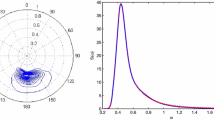Abstract
An extremely large (“freak”) wave is a typical though rare phenomenon observed in the sea. Special theories (for example, the modulation instability theory) were developed to explain mechanics and appearance of freak waves as a result of nonlinear wave-wave interactions. In this paper, it is demonstrated that the freak wave appearance can be also explained by superposition of linear modes with the realistic spectrum. The integral probability of trough-to-crest waves is calculated by two methods: the first one is based on the results of the numerical simulation of a wave field evolution performed with one-dimensional and two-dimensional nonlinear models. The second method is based on calculation of the same probability over the ensembles of wave fields constructed as a superposition of linear waves with random phases and the spectrum similar to that used in the nonlinear simulations. It is shown that the integral probabilities for nonlinear and linear cases are of the same order of values
Similar content being viewed by others
References
Benjamin T B, Feir J E. 1967. The disintegration of wave trains on deep water Part 1. Theory. Journal of Fluid Mechanics, 27(3): 417–430
Chalikov D. 2007. Numerical simulation of the Benjamin-Feir instability and its consequences. Physics of Fluids, 19(1): 016602
Chalikov D. 2009. Freak waves: their occurrence and probability. Physics of Fluids, 21(7): 076602, doi: 10.1063/1.3175713
Chalikov D, Sheinin D. 1998. Direct modeling of one-dimensional nonlinear potential waves. Nonlinear Ocean Waves. In: Perrie W, ed. Advances in Fluid Mechanics. V17. Southampton, UK: WIT Press, 207–258
Chalikov D, Sheinin D. 2005. Modeling extreme waves based on equations of potential flow with a free surface. Journal of Computational Physics, 210(1): 247–273
Chalikov D, Babanin A V, Sanina E. 2014. Numerical modeling of 3D fully nonlinear potential periodic waves. Ocean Dynamics, 64(10): 1469–1486
Janssen P A E M. 2003. Nonlinear four-wave interactions and freak waves. Journal of Physical Oceanography, 33(4): 863–884
Kharif C, Pelinovsky E. 2003. Physical mechanisms of the rogue wave phenomenon. European Journal of Mechanics-B/Fluids, 22(6): 603–634
Kharif C, Pelinovsky E, Slunyaev A. 2009. Rogue Waves in the Ocean: Advances in Geophysical and Environmental Mechanics and Mathematics. Berlin Heidelberg: Springer
Onorato M, Osborne A R, Serio M, et al. 2001. Freak waves in random oceanic sea states. Physical Review Letters, 86(25): 5831–5834
Pelinovsky E, Shurgalina E, Chaikovskaya N. 2011. The scenario of a single freak wave appearance in deep water-dispersive focusing mechanism framework. Natural Hazards and Earth System Science, 11(1): 127–134
Pierson W J, Moskowitz L. 1964. A proposed spectral form for fully developed wind seas based on the similarity theory of S. A. Kitaigorodskii. Journal of Geophysical Research, 69(24): 5181–5190
Shemer L, Goulitski K, Kit E. 2007. Evolution of wide-spectrum unidirectional wave groups in a tank: an experimental and numerical study. European Journal of Mechanics-B/Fluids, 26(2): 193–219
Slunyaev A, Didenkulova I, Pelinovsky E. 2011. Rogue waters. Contemporary Physics, 52(6): 571–590
Author information
Authors and Affiliations
Corresponding author
Additional information
Foundation item: The Rissian Fund for Basic Research under contract No. #14-05-00422; Australian Research Council, Discovery under contract Nos DP1093349 and DP130100227.
Rights and permissions
About this article
Cite this article
Chalikov, D., Babanin, A.V. Comparison of linear and nonlinear extreme wave statistics. Acta Oceanol. Sin. 35, 99–105 (2016). https://doi.org/10.1007/s13131-016-0862-5
Received:
Accepted:
Published:
Issue Date:
DOI: https://doi.org/10.1007/s13131-016-0862-5




